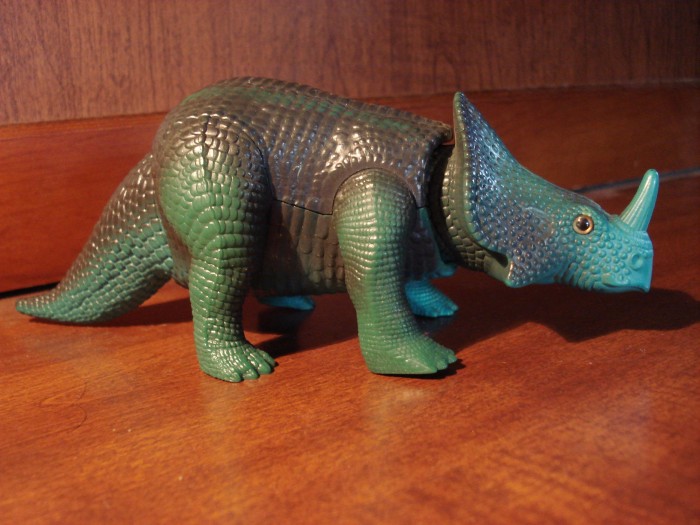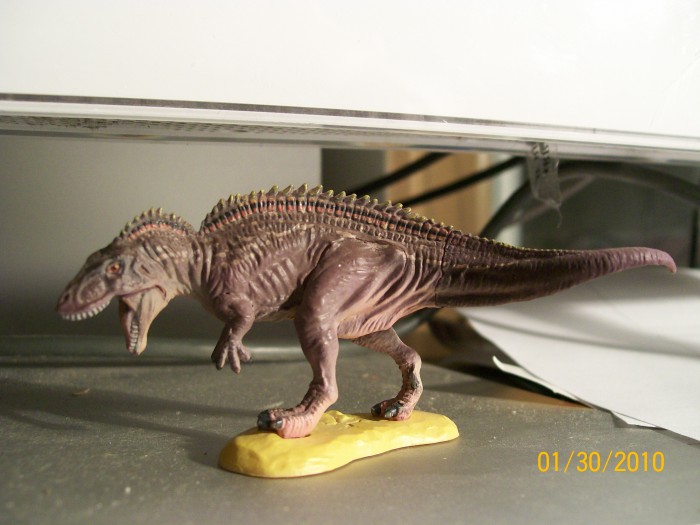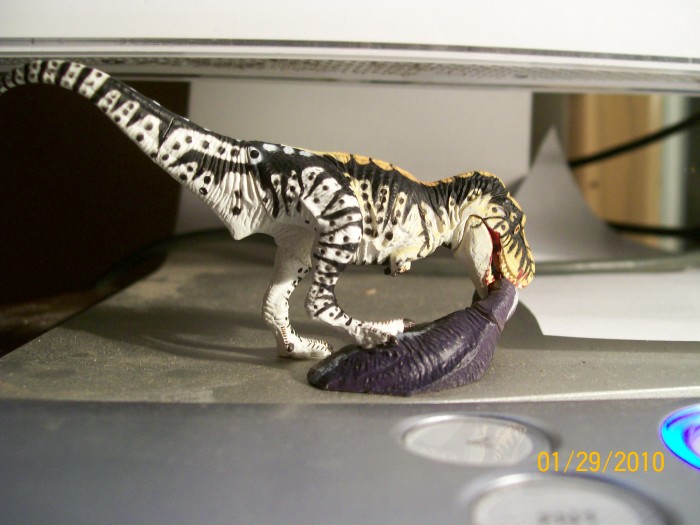Review and photos by Griffin
Monoclonius was always known as a sort of “little brother” to Triceratops, characterized by its short frill and singular nose horn. Sadly for it, like several other dinosaurs I remember growing up with like Trachodon and Brontosaurus, it’s no longer believed to be a valid genus of dinosaur.
Age: Cretaceous
Review: Velociraptor (Papo)

3.6 (20 votes)
Up for review is yet another Papo dinosaur – Velociraptor. This figure is largely praised in the dinosaur toy collecting community, as is the real Velociraptor itself!
Unfortunately, most aspects of this Velociraptor are wrong. The tail is too short and curved, the arms are awkwardly pronated, the tibias seem a little too long, and there’s no feathers – all very un-dromeosaurid like features.
Review: Deinonychus (Soft model by Favorite Co. Ltd.)

3.9 (8 votes)
In spite of not having a name ending in ‘raptor’, Deinonychus remains a high-profile dromaeosaur in the public imagination, and rightly so for an animal that revolutionised our understanding of dinosaurs. This fairly small and affordable toy is manufactured by Favorite, and is clearly modelled on their larger (and somewhat more expensive) resin ‘Desktop’ model.
Review: Acrocanthosaurus (Kaiyodo Dinotales Series 3)
Review: Tarbosaurus (Kaiyodo Dinotales Series 4)
Review: Triceratops (Carnegie Collection by Safari ltd)

3.7 (9 votes)
Review and photos by Griffin
Ever since it was discovered in the late 1800s, Triceratops has remained one of the most well known and iconic dinosaurs of all time. By this I mean it’s actually one of those dinosaur names that an average person with no interest in paleontology taken off of the street would know (A true honor only a select few kinds of dinosaurs have ever been able to claim).
Ever since it was discovered in the late 1800s, Triceratops has remained one of the most well known and iconic dinosaurs of all time. By this I mean it’s actually one of those dinosaur names that an average person with no interest in paleontology taken off of the street would know (A true honor only a select few kinds of dinosaurs have ever been able to claim).
Review: Triceratops (Papo)
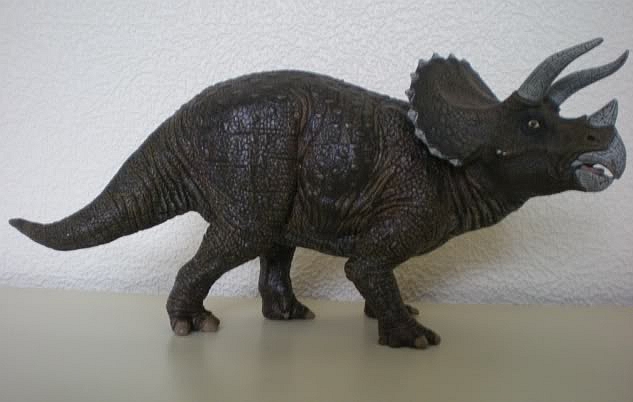
3.9 (21 votes)
In my previous review of Papo’s Parasaurolophus, I pointed out that not all Papo’s pre-Allosaurus dinosaur figures were necessarily Jurassic Park copies – but this Triceratops definitely is. It will therefore be more appealing to JP fans than anyone else, but like all Papo figures it’s quite a nice piece in its own right.
Review: Parasaurolophus (Papo)
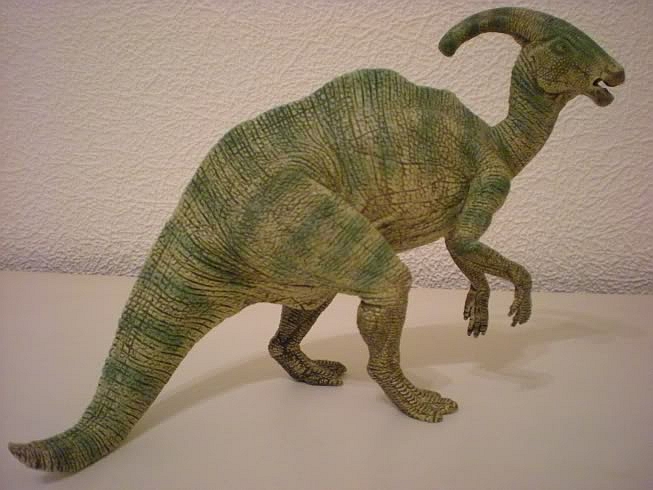
3.6 (23 votes)
Until the release of their Allosaurus, Papo’s prehistorics garnered attention mainly for being remarkable facsimiles of their Jurassic Park counterparts. However, even before Papo’s own Big Al hit the scene the company had released a sculpt not obviously based on a JP creature – this often-overlooked Parasaurolophus (dated 2005) at about 1:35 scale.
Review: Spinosaurus (Kabaya)

3.3 (8 votes)
Review and photos by Brandon. Edited by Plesiosauria.
Spinosaurus aegyptiacus, the “Egyptian Spine Lizard” is the largest known theropod that ever existed to be known thus far, surpassing Giganotosaurus at both weight and length! The “Spine Lizard” is one lucky dinosaur, it was once found in 1912 and named three years later by Ernst Stromer Von Reichenbach but its remains were destroyed during bombing in World Ward Two.
Spinosaurus aegyptiacus, the “Egyptian Spine Lizard” is the largest known theropod that ever existed to be known thus far, surpassing Giganotosaurus at both weight and length! The “Spine Lizard” is one lucky dinosaur, it was once found in 1912 and named three years later by Ernst Stromer Von Reichenbach but its remains were destroyed during bombing in World Ward Two.
Review: Maiasaura (Carnegie Collection by Safari Ltd)
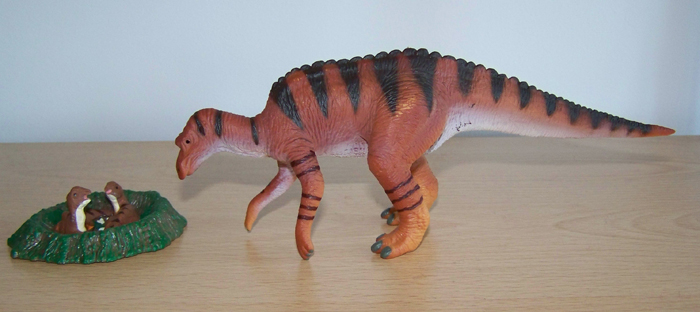
4.6 (15 votes)
The discovery and description of fossil hadrosaur nesting grounds in the Cretaceous of North America provided some of the best evidence for parental care in dinosaurs. The association of fossils at the so-called ‘egg mountain’ site in Montana included eggs, babies and adults of a single species of dinosaur; crushed egg shells indicated that the babies spent time in the nest after hatching and were probably looked after by adults of the same species.
Review: Tenontosaurus (Collecta/Procon)
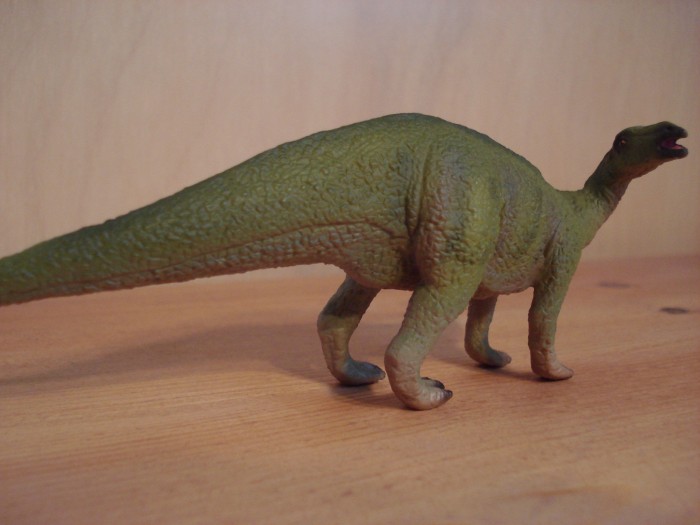
2.6 (15 votes)
Review and photos by Griffin
Tenontosaurus was an Iguanodontid ornithopod dinosaur that lived in the Western United States during the early Cretacious period. In life it would have co-existed with dinosaurs like Iguanodon, Dienonychus, Utahraptor and Acrocanthosaurus. Thanks to a Tenontosaurus skeleton discovered with Dienonychus chew marks on its bones in addition to Dienonychus skeletons nearby, the idea of pack-hunting Dromaeosaurs is now widely accepted. Unfortunately this has also lead to the image of poor Tenontosaurus to ALWAYS be the prey item for Deinonychus. (Seriously, google image search “Tenontosaurus”. Like 80% of the images that pop up will be of it being attacked and/or eaten by the Deinonychus.) Medullary bone tissue, which is used by modern birds for laying eggs, has also been found on the bones of Tenontosaurus fossils.
Tenontosaurus was an Iguanodontid ornithopod dinosaur that lived in the Western United States during the early Cretacious period. In life it would have co-existed with dinosaurs like Iguanodon, Dienonychus, Utahraptor and Acrocanthosaurus. Thanks to a Tenontosaurus skeleton discovered with Dienonychus chew marks on its bones in addition to Dienonychus skeletons nearby, the idea of pack-hunting Dromaeosaurs is now widely accepted. Unfortunately this has also lead to the image of poor Tenontosaurus to ALWAYS be the prey item for Deinonychus. (Seriously, google image search “Tenontosaurus”. Like 80% of the images that pop up will be of it being attacked and/or eaten by the Deinonychus.) Medullary bone tissue, which is used by modern birds for laying eggs, has also been found on the bones of Tenontosaurus fossils.
Review: Tyrannosaurus rex (red version) (by Kabaya)
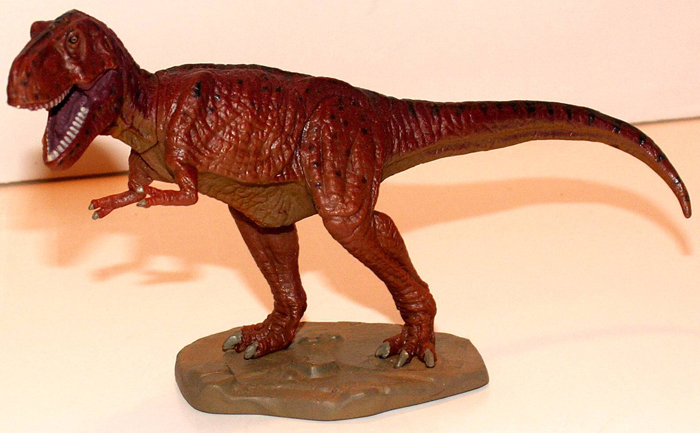
4 (7 votes)
Review and photos by Brandon. Edited by Plesiosauria.
The red Tyrannosaurus differs greatly compared to the Kabaya green T. rex (reviewed here) for three major reasons. One is that it seems to be paying homage to a classical standing posture. Second is the main color scheme which is red – the overall sculpt resembles Diablo, the red Tyrannosaur of Primal Rage, the great Atari Probe video game of the 1990s.
The red Tyrannosaurus differs greatly compared to the Kabaya green T. rex (reviewed here) for three major reasons. One is that it seems to be paying homage to a classical standing posture. Second is the main color scheme which is red – the overall sculpt resembles Diablo, the red Tyrannosaur of Primal Rage, the great Atari Probe video game of the 1990s.

